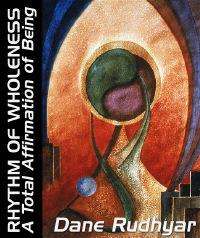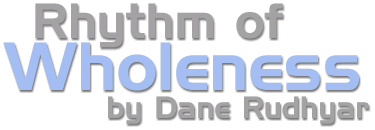 |
| Home | Bio | Art | Music | Literature | Civilization & Culture | Philosophy of Wholeness | Theosophy & Spirituality | Astrology |

RHYTHM OF WHOLENESS A Total Affirmation of Being by Dane Rudhyar, 1983 CONTENTS PROLOGUE PART ONE The Philosophy of Operative Wholeness 1. Prelude to a New Interpretation of Reality 2. The Search for Spiritual Security: The One, the Whole, and Wholeness 3. The Movement of Wholeness PART TWO The Cycle of Being 4. The Structure of the Cycle of Being 5. The Four Crucial Phases of the Cycle of Being 6. The Inevitability of Success and Failure 7. Spirit and Mind PART THREE The Cycle of Man 8. Constitution of Man - The Physical and Psychic Bodies Page 1 Page 2 Page 3 Page 4 9. Constitution of Man - The Spiritual Entity and the Higher Mind 10. The Structure and Transformation of the Total Person 11. The Cyclic Process of Spiritual Embodiment PART FOUR In The Spirit of Wholeness 12. The Principle of Holarchy and the Interplay of Horizontal and Vertical Relationships 13. Transpersonal Activity versus Mediumship 14. Rites of Passage EPILOGUE |

CHAPTER EIGHT
Constitution of Man - The Physical and Psychic Bodies - 4 With the assistance of what I presently shall call the concretizing mind, psychism "precipitates" as a psychic structure. The latter is a field of forces rather than a "body," yet it operates somewhat as a body. It can be called a body of desires. The term desire should be understood in its basic sense. All desires are desires for relationship with other entities, be they persons, objects or the kind of power that makes possible the possession of persons or objects (for example, money, fame, authority, and so on). In Sanskrit, desire is kama, a word with many meanings; but the English word desire also has many meanings, some positive, some negative. It can refer to love or hatred, possessiveness or repudiation. Desire also can apply to devotion and faith. In its most sublime aspect, desire is the Compassion emanating from the Godhead state; and religious cosmologies speak of the motive for the creation of the universe as God's "desire" for manifestation. The psychism experienced by the members of a tribe (and even by members of a more complex, less homogenous culture-whole) results from a powerful desire for interpersonal relatedness. This yearning is kama at work — just as the mating urge that compels male and female to embrace is life at work. Mating unites biological structures; psychic love unites the psychic "bodies" of persons. The psychic or desire body also has been called the "astral body" — a rather confusing term. Its original meaning may be understood by thinking of the sky as ancient Chinese philosophers did. The basic aim of Chinese culture was to make society ("the State") a reflection of the majestic order- revealed by the sky. Chinese familial, social, and cultural life was highly ritualized; every relationship was part of a ritual that was meant to reflect the celestial order of the stars and planets as they moved across the sky. The sky was thus the "astral body" of the Chinese state, and the emperor and his astrologers tried to make sure that the complex interplay of family and social relationships would reflect celestial order. They used "music, rites, and chastisements" to accomplish this end. Similar means traditionally have been used in the West: the deliberate arousal of religious faith, observances of various kinds, and moral or sociocultural sanctions, including excommunication and (under the Inquisition) torture — all of which were intended for the sake of the soul. What was meant by "soul" in this case was none other than the astral body or psychic self — the body of desires. Culture and religion were meant to transmute the desires of the person — the sociocultural unit — from selfish and biologically impelled desires to the desire for salvation through faith, altruism, and neighborly love. The purpose of devotion to Christ or to the Church, in India to a guru, was the transformation of the many desires for possessive and satisfying relationships into one single stream with a spiritual object. At the lower level of psychic desire, the soul was called the "animal soul" or less pejoratively, the "living soul"; its highest level was termed the "divine soul." In most human beings the soul was torn by a crucial conflict between the animal and the divine; the results of such a conflict during a person's life span determined, after a symbolic "Judgment," what the state of being after death would be. In Christian tradition, three possibilities were dramatized as heaven, purgatory, and hell. Yet neither philosophers nor theologians have made clear that the whole realm of desire inevitably develops out of the human state of sociocultural living. While this state is rooted in biology, it nevertheless transcends "life." While a physical body is an organism of cells, a strongly integrated society and culture is an organization of persons. As a result the basic energies at work differ at each level of organization. Relationships operating at the biological level differ qualitatively from the relationships of the sociocultural level of psychism. As long as a human being operates as a physical body, his or her psychic energy is deeply related to and dependent upon life energy; but when the physical body disintegrates, the psychic body of desire operates alone. A psychic body is the product of interpersonal, sociocultural relationships. If a human being were born alone and could live without any relationships with other human beings, he or she would have no psychic body. He or she would be a protohuman animal, not a human being. Protohuman manifestations of life become at least potentially human at the Noon of the cycle, when they are gathered together in tribal groups, by the descent of the power of the Godhead through the primordial Avatar. Avatars periodically appearing among men-in-the-making give them potent Images which become the foundation of sociocultural living and therefore of development at the level of psychism, which at that phase of the cycle refers to the collective soul of the tribe. Human beings have desires insofar as they are "human," insofar as they are "persons," that is, members of a society and culture. Animals have instincts. Men and women acting as biological organisms also can act compulsively in an instinctual way, but such actions are animal rather than human. To the extent a human being is a person, personalized desires operate, and these desires are conditioned, and often totally predetermined, by the sociocultural patterns of the person's tribe, social class, and particular religion. Even today, the drive for wealth and personal comfort experienced by human beings born and trained in the United States is a collective desire characterizing the national psychism. Each person gives this collective psychic drive a more or less particularized coloring or form according to his or her temperament and circumstances of birth and education. Today, however, these collective desires can become individualized, because the process of individualization has begun to operate at the planetary level, making at least some impression on the collective psychism of all peoples. This process has begun because at the planetary level of mankind-as-a-whole the Movement of Wholeness has reached a phase at which the principle of Unity is gaining greater power — yet not sufficient power to balance the principle of Multiplicity. Symbolically speaking, mankind may have reached a point just past the midpoint between Noon and Sunset. The process of individualization implies the increasing possibility for human beings to develop what might be called a "body of individuality," as distinct from the psychic body of desire as the latter is distinct from the living physical body. What then is this "body of individuality?" Essentially it is a "mental" structure, using the term mental in the complex sense in which mind was defined in the preceding chapter. As a formative agent, mind can operate either as the servant of a spiritual Quality (one of the many Letters of the creative Word) endeavoring to establish a one-to-one relationship with an individual person — or as the servant of the "desire nature" dominated by vitalistic drives and the imperatives of a particular culture and collective tradition. By permission of Leyla Rudhyar Hill Copyright © 1983 by Dane Rudhyar All Rights Reserved.  Web design and all data, text and graphics appearing on this site are protected by US and International Copyright and are not to be reproduced, distributed, circulated, offered for sale, or given away, in any form, by any means, electronic or conventional. See Notices for full copyright statement and conditions of use. Web design copyright © 2000-2004 by Michael R. Meyer. All Rights Reserved. |
 |